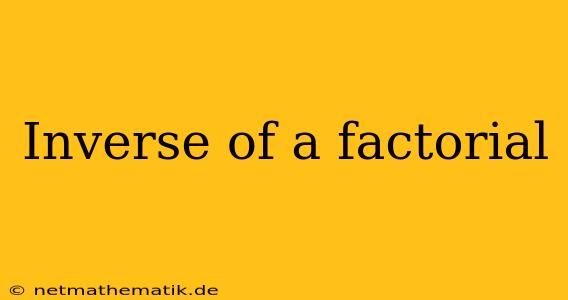The inverse of a factorial, denoted by !⁻¹, is a mathematical function that seeks to find the number whose factorial equals a given value. While the factorial operation calculates the product of all positive integers less than or equal to a given number, its inverse aims to reverse this process. This article delves into the intricacies of the inverse of a factorial, exploring its definition, properties, and practical applications.
Understanding Factorials and Their Inverses
Before delving into the inverse of a factorial, it's crucial to understand the concept of factorials themselves. For a non-negative integer n, the factorial of n, denoted as n!, is defined as the product of all positive integers less than or equal to n.
Example:
- 5! = 5 * 4 * 3 * 2 * 1 = 120
The inverse of a factorial, denoted as !⁻¹, is a function that takes a number y as input and returns the number x such that x! = y. In essence, it attempts to "undo" the factorial operation.
Example:
- If we know 5! = 120, then !⁻¹(120) = 5.
Challenges in Calculating the Inverse of a Factorial
Unlike the factorial operation, which has a straightforward formula, calculating the inverse of a factorial presents unique challenges:
- Non-integer Values: The inverse of a factorial is generally not defined for non-integer values. Factorials are only defined for non-negative integers, and their inverses only exist for values that correspond to factorials.
- Lack of a Closed-Form Formula: There is no explicit closed-form formula for calculating the inverse of a factorial. This means we cannot directly compute !⁻¹(y) for any given y.
- Computational Complexity: Finding the inverse of a factorial often requires iterative methods or approximations. These methods involve searching for the appropriate integer whose factorial matches the input value.
Methods for Approximating the Inverse of a Factorial
Since a closed-form formula for the inverse of a factorial is unavailable, we rely on numerical methods to approximate its value. These methods include:
1. Iterative Search
This method involves systematically calculating factorials of increasing integers until we find one that is equal to or greater than the input value. The integer corresponding to the factorial closest to the input value provides an approximation of the inverse.
Example: To find !⁻¹(24), we can start by calculating 2!, 3!, 4!, and so on. We find that 4! = 24, so !⁻¹(24) = 4.
2. Approximation Formulas
Several approximation formulas have been developed to estimate the inverse of a factorial. These formulas often rely on properties of the factorial function and provide an approximate value that gets closer to the actual value as the input increases.
Example: The following approximation formula provides a reasonable estimate for !⁻¹(y) for large values of y:
!⁻¹(y) ≈ (log(y)/log(2π)) + (log(y)/2) + (log(y)/log(e)) - (log(y)/log(12))
3. Numerical Libraries and Software
Many programming languages and software libraries offer built-in functions or algorithms for calculating factorials and their inverses. These tools often employ more sophisticated numerical methods to provide accurate approximations, especially for large input values.
Applications of the Inverse of a Factorial
While the inverse of a factorial might seem like an obscure mathematical concept, it finds practical applications in various fields:
- Combinatorics: The inverse of a factorial is used in combinatorial problems involving permutations and combinations. For example, if we know the number of permutations of a set, the inverse of a factorial can help us determine the original number of elements in the set.
- Probability: The inverse of a factorial appears in certain probability calculations, particularly those involving the Poisson distribution. This distribution models the probability of a given number of events occurring in a fixed interval of time or space.
- Computer Science: The inverse of a factorial is useful in algorithms involving sorting, searching, and data analysis. For instance, in algorithms that rely on the factorial function for efficiency analysis, the inverse of a factorial can be employed to determine the number of operations required for a given input size.
Conclusion
The inverse of a factorial, while lacking a direct formula, plays a significant role in various mathematical and scientific disciplines. Its application in combinatorics, probability, and computer science highlights its importance in understanding and solving complex problems.
While approximating the inverse of a factorial might require numerical methods, its existence and use provide valuable insights into the behavior of factorials and their relationship to other mathematical concepts. By understanding the challenges and methods involved in calculating the inverse of a factorial, we can gain a deeper appreciation for the intricacies of this fascinating mathematical function.
